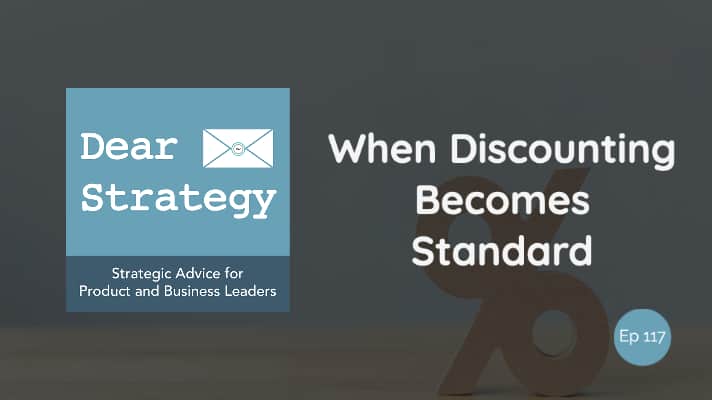On this episode of Dear Strategy, we analyze the practice of retailers offering so many coupons that their discounted prices pretty much become their standard prices. And we talk about how customers feel when everyone else has coupons but them!
When I started doing these “strategy stories” at the beginning of this year, the idea was to feature real-life experiences that people are having with companies, and then analyze the likely strategies behind those situations. Admittedly, this is a bit of a one-sided approach since my analysis of why a company behaves a certain way in any given situation is going to be an educated speculation at best. But that’s also part of the point. In my experience, it’s all-too-common, especially in the corporate world, for certain strategies to become “trendy.” In other words, one company does something, and then, before you know it, that becomes the new industry norm. Sometimes these practices are truly beneficial to companies and consumers alike. But, other times, it seems that these practices have been adopted without ever truly considering the impacts that they’re going to have on the customers they’re meant to serve. And that’s the whole point of these stories – to give companies a chance to step back and question whether or not these are really the right strategies for them.
Which brings us to this week’s story, which, at least on the surface, would appear to be completely in the consumer’s favor. What we’re talking about, of course, is the practice of companies offering so many coupons that their discounted pricing essentially become their new normal. So, let’s take a look at how this works…
In a normal world, companies issue coupons to lure in price-sensitive customers who they may not have been able to access otherwise. This not only helps companies boost their sales and grow their relative shares, but it also allows them to test their pricing on certain market segments that they may or may not be interested in doing business with.
Sometimes, however, companies take this approach to an extreme; issuing coupons so frequently that their discounted pricing effectively become their standard retail price. In these cases, the strategy is probably less about growing customers and more about retaining customers by making them feel like they’re always getting some sort of a bargain. So let’s play this out a bit…
“The strategy is probably less about growing customers and more about retaining customers by making them feel like they’re always getting some sort of a bargain.”
If I’m shopping for a new set of cookware, I might consider going to Store A, where I know the prices are already low, or I might consider going to Store B, where I always have access to a 20% coupon. In my mind, the end prices are probably going to be close to the same. But my assumption is that the product in Store A is somehow of lower quality because the price is already so low to begin with. Whereas, in Store B, I feel like I’m getting a higher quality item for a really great price.
With that setup, it would appear that adopting this strategy could very well give companies the best of both worlds – allowing them to offer discounted prices behind the veil of a non-discounted storefront. But, like most things, there are some downsides to this approach that need to be taken into account as well.
For one thing, there’s a lot of extra maintenance involved with coupons – for both the company and the consumer. Companies have to print them, mail them, manage them, etc., while consumers have to clip them, carry them, and remember to use them before they expire. So there is definitely an inconvenience factor that comes into play here.
Then there’s the issue of those select few customers who somehow seem to have “missed the memo.” We’ve all seen it happen – everyone is standing in line with their Ziploc bag full of coupons; all with the exception of that one solitary customer who had no idea that this was even a thing! Unfortunately, when this scenario plays out, it’s pretty much a no-win scenario for just about everyone involved. If the store goes by the book and refuses to offer a discount without a coupon, this leaves the customer with no choice but to either grumpily pay full price, or even more grumpily walk away from the transaction altogether. If, on the other hand, the store allows its cashiers to scan one of those “coupons-for-all” that they’ve secretly stashed behind each register, then the rest of us are left wondering why we had to carry around all those silly bags full of coupons in the first place!
So, like any strategy, there are pros and cons. And the best we can hope for is that all of these things are carefully weighed before a company decides to go one way or another.
A related but perhaps less extreme version of discounting can also be seen by those companies that habitually offer coupons as special promotions. This often happens around holidays or other deliberate times of the year – but, in any event, frequently enough to cause at least some percentage of their customers to “wait for the next coupon” before making any major purchases. So the likely goal of boosting revenues during certain critical times of the year could very well be offset by the unintended creation of revenue “valleys” during the periods when those coupons aren’t valid.
As an example, there is a company that I love to buy from in the music technology space that issues coupons on a regular enough basis that I’ve pretty much come to know their patterns. The result is that, yes, I’m definitely helping them boost their revenues during the times that they clearly want me to buy from them. On the other hand, I almost never make any purchases from this company outside of their coupon periods because, well, why would I? The key here is that most of the products I buy from this company are “nice-to-haves” rather than “have-to-haves.” So, the inevitable result of their discounting strategy is that I only make purchases from them when they issue coupons. Perhaps this is all by design. Or perhaps they’re luring in enough new customers with those coupons that it doesn’t really matter. But, whatever the case, all of these implications need to be carefully contemplated and analyzed before letting the proverbial coupon genie out of the bottle.
Overall, the point of all this is certainly not to say that discounting is a bad thing. Far from it (especially from a consumer standpoint). But discounting does drive certain behaviors; and it’s important that companies take the time to understand and analyze what those behaviors are likely to be, and to ensure that they’re aligned with the results they’re trying to achieve. For most really large retailers, I assume this has all been well-studied and even more well-thought out. But my experience has also shown me that one must never assume! So I thought it was worth mentioning just in case…
Listen to the podcast episode
Dear Strategy: Episode 117

Are you interested in strategy workshops for your product managers or business leaders? If so, please be sure to visit Strategy Generation Company by clicking the link below:
 Bob Caporale is the founder of Strategy Generation Company, the author of Creative Strategy Generation and the host of the Dear Strategy podcast. You can learn more about his work by visiting bobcaporale.com.
Bob Caporale is the founder of Strategy Generation Company, the author of Creative Strategy Generation and the host of the Dear Strategy podcast. You can learn more about his work by visiting bobcaporale.com.







